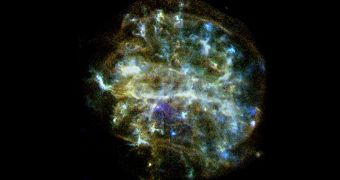A new study conducted by researchers at the Massachusetts Institute of Technology (MIT), in Cambridge, suggests that the earliest stars to have formed in the Universe may have not been the giant behemoths astronomers made them out to be.
This conclusion is based on a star located just a few thousands of light-years away, which contains very low amounts of iron. Astronomers have established that this object is a second-generation star, meaning that it formed from cosmic gas enriched with elements heavier than hydrogen or helium.
The first stars that formed in the Universe were primarily made out of hydrogen, but synthesized heavier elements through nuclear fusion at their cores. As they reached the end of their main sequence, and exploded into powerful supernovae, they seeded the surrounding space with these elements.
Later on, enriched gas clouds collapsed on themselves yet again, and formed new stars. Therefore, with each generation of new stars, their heavy elements content, or metallicity, increases. The fact that the newly-discovered star features so little iron suggests that its precursors – first-generation stars – may have not been as large or as energetic when they exploded as astronomers first thought.
Previous hypotheses suggested that the earliest stars were massive, luminous, and short-lived objects, which inevitably exploded as supernovae when they became unable to support nuclear fusion. Whereas a massive star lives for just a few hundred million years, dwarfs like the Sun can live for 10 billion years.
The star used for this study is called SMSS J031300.36-670839.3. Details of the research appear in a paper published in last week's issue of the top scientific journal Nature. Researchers say that this star has 10 million times less iron than the Sun. This object has the lowest iron concentration of any star discovered to date.
“This star had a lower-than-expected explosion energy, and also lower than today’s regular supernovae, which was really an unexpected finding,” explains Anna Frebel, a coauthor of the new study, who is also an assistant professor of physics at MIT, and a member of the Kavli Institute for Astrophysics and Space Research.
“That tells us that, to some extent, we have to go back to the drawing board, because there is more variety amongst this very first generation of stars than we have assumed so far,” she goes on to say.
“By zooming in on an early star and finding something slightly unusual that goes a bit against the mainstream view, we’ve sort of rattled theory a little in a good way to say, ‘Maybe we have to rethink how the first stars formed’,” Frebel concludes.

 14 DAY TRIAL //
14 DAY TRIAL //